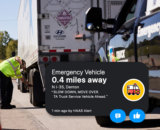/// Guest post by contributor Jon Scharingson, Renewable Energy Group
Making the jump to selling biodiesel can be a significant decision for truckstop and travel plaza owners. Each location needs to determine what will work best for each location and how they can maximize their profitability through the use of biodiesel. While there are a number of considerations to examine, determining the ideal blend level should the focal point.
In every state, biodiesel can be blended with traditional petroleum diesel up to 5 percent; at this B5 blend level, the fuel still meets ASTM D975 fuel specifications and does not require any additional labeling at the pump. Once retailers begin to sell blends from B6 to B20, labeling is required.
Biodiesel blending economics are a fundamental way to enhance fuel margins within a travel center.
The margins are really tight at retail in the travel center business. Owners can find that they can go from making fractions of a cent per gallon up to two, three or four cents per gallon when they add biodiesel to their service offerings.
Providing higher percentages of biodiesel can be a simple way to maximize the economic advantages of the fuel; B10 and B20 retailers are able to achieve a greater gross margin per gallon than if they were selling B2 or B5. Once a truckstop becomes comfortable with the lower blend levels and they see the positive impact on their bottom line, it is then fairly easy to move into higher blend levels to help maximize economics.
Bolstering these economic impacts are the state blending incentives that continue to develop throughout the country. If a travel center owner operates locations in several states, they need to be aware of each state’s individual laws.
In Illinois, for example, many retailers blend at B11 levels and above year-round to help take advantage of the state excise tax abatement. In Iowa, there is an incentive in place for B5 blends of four-and-a-half cents per gallon. Texas, California, Minnesota and Pennsylvania are also among the states pioneering incentives for blending biodiesel or improving biodiesel infrastructure.
Additionally, if you want to make an infrastructure investment in your travel center, to potentially put in a biodiesel tank or blending system, there are a number of states that offer grants or loans to help travel centers make an investment in blending systems.
Retailers who have made the switch are fast seeing the benefits of providing an economically advantageous, easily implemented alternative fuel.
/// Read more guest posts on biodiesel posts here.
{Guest Post} Guest post provided by NATSO Chairman's Circle member Jon Scharingson, Renewable Energy Group. Renewable Energy Group® is a leading North American biodiesel producer with a nationwide distribution and logistics system. With more than 210 million gallons of owned/operated annual production capacity at biorefineries across the country, REG is a proven biodiesel partner in the distillate marketplace. Learn more about Renewable Energy Group.
The opinions and advice given by guest post contributors are not necessarily those of NATSO Inc. The posts should not be considered legal advice. Qualified professionals should be sought regarding advice and questions specific to your circumstances.
Subscribe to Updates
NATSO provides a breadth of information created to strengthen travel plazas’ ability to meet the needs of the travelling public in an age of disruption. This includes knowledge filled blog posts, articles and publications. If you would like to receive a digest of blog post and articles directly in your inbox, please provide your name, email and the frequency of the updates you want to receive the email digest.


